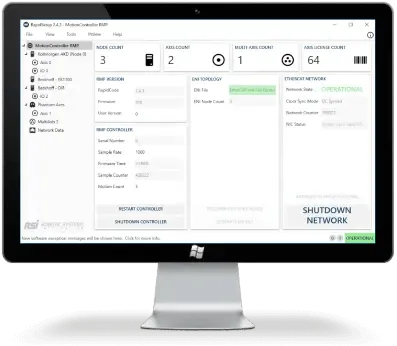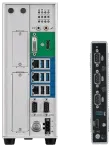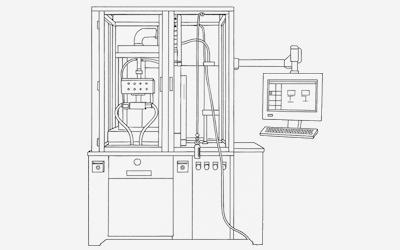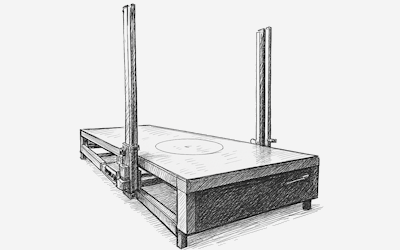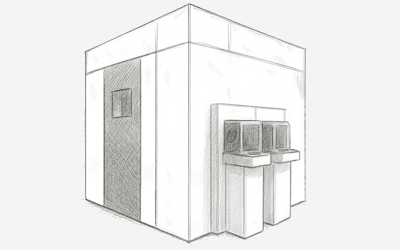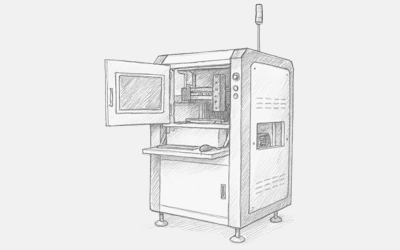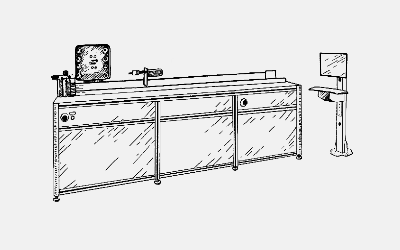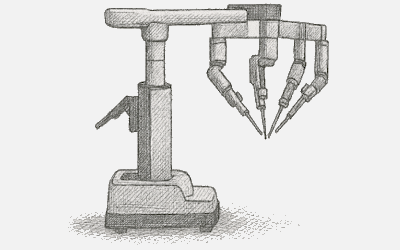Case Study
Automatic Cutting Machine
Our customer builds Automatic Material Cutting Machines—high-precision systems that cut raw materials into predefined shapes for manufacturing. Their cutters can process flexible fabrics like Kevlar or fiberglass-polyester blends just as easily as rigid sheet materials, including cotton and nylon to difficult composites. The key to this versatility is a robust multi-axis motion platform combined with advanced tool control, allowing one machine to serve automotive upholstery, aerospace composite layups, apparel production, and more with equal precision.
The customer adopted the RMP — PC-based EtherCAT Master and Motion Controller and have been a happy customer for 25+ years.
Machine Configuration
Their automatic cutting machine is built as a gantry-style CNC system with 3 to 5 servo-controlled axes, sensors, and actuators, each dedicated to specific tasks:
- X and Y Axes (Linear Gantry Motion): These orthogonal axes precisely move the cutting head over the material. The X-axis is a long gantry spanning the table, driven by dual synchronized servo motors to ensure stability and prevent racking. The Y-axis, mounted on the gantry, enables side-to-side tool movement, facilitating complex contours and patterns.
- Z Axis (Tool Height and Pressure): Controls vertical tool positioning for blade depth, laser focus, or router cut depth. It rapidly lifts or applies downward force as needed, essential for piercing materials and avoiding obstacles.
- Theta Axis (Tool Rotation or Angle): A rotary servo that continuously aligns cutting tools, such as tangential knives, to curves. It ensures precise cuts on corners and intricate shapes, especially useful for thick or multi-layer materials.
- Conveyor Axis (Material Feed)—optional: Enhances throughput by moving materials incrementally or dynamically via a conveyorized cutting bed. This axis automatically advances new materials and removes cut pieces, supporting continuous, high-volume operations.

Solution
Why the customer chose RMP EtherCAT Master and Motion Controller
Choosing a controls system required deciding between traditional PLCs, CNC controllers, or PC-based soft motion solutions. They selected RSI’s RMP EtherCAT Master and Motion Controller for several key reasons:
- Real-Time Performance on Standard PC Hardware: RMP converts a standard industrial PC into a robust motion controller by using real-time OS options like Windows with INtime RTOS or Linux with PREEMPT_RT. They chose Windows+INtime for familiarity and GUI integration, knowing Linux deployment remained an option. RMP ensures deterministic, jitter-free performance with sub-millisecond control cycles. Their machine currently runs at 1 kHz, but RMP supports 500 Hz to 8 kHz loops. Testing confirmed that a multicore PC running RMP matched dedicated hardware controllers in reliability and performance without proprietary limitations.
- High Axis Count and Advanced Coordination: RMP supports up to 128 coordinated axes and extensive I/O, far beyond our immediate needs but offering valuable future scalability (e.g., robotic arms or multi-head gantries). Key advanced motion features include
- Coordinated Multi-Axis Interpolation: Precisely synchronizes axis movements, crucial for accurate diagonal and curved trajectories.
- Motion Blending and Contouring: Smoothly transitions through small line/arc segments without stopping, critical for fluid cutting operations.
- Electronic Gantry Control: Electronically synchronizes dual motors on our Y-axis, automatically correcting any deviations, simplifying tuning and preventing mechanical skew.
- Feed rate Override and Real-Time Adjustments: Allows smooth, real-time speed adjustments during operation, enhancing operator flexibility.
- Electronic Gearing: Offers synchronization features valuable for future equipment integrations, such as feeders or multiple cutting heads.
- Integrated I/O and Deterministic Timing: RMP synchronizes motion and I/O updates within the same 1 ms real-time cycle, eliminating delays inherent with separate PLC systems. This synchronization allows precise event triggering (tool changes, laser activation) and custom real-time tasks for functions like homing and sensor monitoring.
- Familiar Windows/Linux Development Environment: PC-based control means leveraging standard development environments. Using C++ and C# with RMP’s RapidCode API simplified implementing complex features and allowed running our HMI, logic, and motion control on one PC.
- No Proprietary Hardware Required: RMP relies solely on software and standard EtherCAT NICs, eliminating proprietary hardware constraints.
G-Code Integration
One reason they chose RMP was its integrated G-code interpreter. Instead of developing their own parser and planner, they used RMP’s proven library to stream and execute G-code directly. This saved significant development time and gave them a reliable, high-performance tool chain. RMP supports standard G-code instructions, and the customer extended it with custom M-codes.
The Benefits:
- Faster Development to Production:
They avoided building a custom motion language, focusing instead on machine mechanics and user interface. - Operator Familiarity:
Most operators were already using G-code-based systems, so training on their end was minimal and errors were fewer. - Advanced G-code Capabilities:
RMP supports macros, variables, loops, subroutines, and work offsets. This enabled the customer to build parametric programs and sophisticated operations on par with high-end CNC machines. - Custom Extensions:
They implemented inline commands for advanced features, like vacuum control or knife frequency adjustment. For example, one custom M-code pauses motion, captures a camera image, applies an offset, and resumes cutting—all driven from a G-code file.
Additional Capabilities and Innovations
One major advantage of building their system on RMP is how easily they could expand beyond cutting. With everything integrated into one platform, adding automation for material handling became straightforward.
Material Handling Integrations
In high-volume production, cutting is just one part of the workflow. The customer designed their machine to handle automation at both the input and output stages:
- Automatic Material Loading:
They integrated an auto-spreader and conveyor feed that loads layered material onto the cutting table. A single G-code command (like M30) can trigger the full reload cycle—vacuum release, conveyor advancement, and material feed—dramatically reducing downtime and enabling near-continuous cutting. - Automated Part Unloading and Sorting:
Cut parts can be offloaded via conveyor extensions or picked by a robotic system. With RMP running on a PC, they can easily interface with robots using EtherCAT. This allows coordination between their motion system and the robot—avoiding collisions or enabling part tracking from a moving belt. - Material Sensors and Feedback:
They included sensors to detect roll end, tension, and slack. These signals feed into RMP’s real-time EtherCAT I/O, which triggers pauses or adjusts speeds as needed. For example, if tension spikes, the controller slows the feed or moves the head to a safe position.
By controlling both motion and material handling in a unified system, they improved reliability, reduced idle time, and eliminated the complexity of syncing separate PLCs.
Vision and AI-Driven Innovations
Our PC-based RMP controller gives us the flexibility to integrate advanced capabilities that go well beyond basic motion control:
- Vision-Guided Alignment: A future camera system could auto-align cut paths to printed graphics or fabric skew—eliminating manual tweaks and improving accuracy.
- Automated Inspection: Vision could scan cut edges and compare to CAD to catch errors early, reducing scrap and ensuring quality.
- Predictive Maintenance via AI: Logged machine data can feed future AI models to detect blade wear or vacuum issues before they cause downtime.
- Unified Architecture: Motion, I/O, vision, and AI run on one PC. RMP’s API enables seamless coordination, faster development, and simplified diagnostics.
- Built for the Future: We can tap into open-source tools like OpenCV and TensorFlow, making it easy to evolve the system with smarter features like nesting optimization or voice commands.
Conclusion
Choosing the RMP EtherCAT motion controller for their Automatic Material Cutting Machine proved to be the right decision. It gave them the real-time performance, flexibility, and integration power that traditional controllers couldn’t match. With RMP, they unified motion, I/O, and automation in a single PC-based platform.
Testimonial
Technologies
Benefits
Images
Additional
On this page


